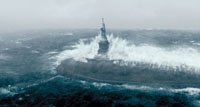RCA Scenium HD50LPW175 50-inch DLP HDTV Page 2
| The Short Form |
| RCA.COM / 800-336-1900 / $2,499 / 53 x 32 x 15.25 IN / 70 LBS |
| Plus |
| •Low price. •Doesn't crush detail in white areas. •Good color reproduction. |
| Minus |
•720p could look sharper. •Modest video noise. •Loses detail in darker scenes.  |
| Key Features |
| •50-inch (diagonal) screen •Smooth Picture DLP chip •CableCARD-ready with TV Guide On Screen program guide •HDMI input, 2 HDTV-capable component-video inputs |
| Test Bench |
| Even after calibration, this TV was fairly bright (55.5 ftL) and noticeably blue on the darkest end of the grayscale. Thankfully, most of the grayscale hovered closely (within 60 K) around the 6,500-K reference standard. Color decoding was nearly spot on. Resolution test patterns confirmed that the set doesn't fully resolve 720p HDTV signals. Full lab results |
PICTURE QUALITY The Day After Tomorrow is an apocalyptic rollercoaster of a movie in which the Earth descends into another ice age due to the horrors of global warming. Much of it is set in New York City - some scenes, in fact, eerily close to the S&V test lab. The RCA delivered nicely on the signature colors of the city lights and yellow cabs, which were pleasingly bright and appropriately saturated without being overblown.
After New York loses power, Sam (Jake Gyllenhaal) leads a mission aboard an abandoned freight ship to find penicillin for the lovely Laura (played by Emmy Rossum). As Gyllenhaal and company raced through the ship's dim hallways, though, the RCA's trouble producing blacks came to light. The rough texture of the ship's walls and the forms of doorways in the distance were reduced to blobs with little or no detail, and darker portions of the picture were consistently plagued by a noticeable amount of noise.
Outside, on the deck of the ship, however, in the ever-present blizzard of the new ice age, the RCA did a wonderful job of presenting the subtle shades of white in the falling snow. Many microdisplays, even many expensive plasmas and LCDs, would crush the whites in this scene, presenting an overly bright uniform mass devoid of detail. This can be brutal to watch for any length of time. Given the number of snowy scenes in this movie, I was grateful at how easily and accurately this TV conveyed the intensity of the storm.
Not surprisingly, high-definition material is where the RCA looked its best. Watching Monster Garage on Discovery HD, I was awash in color and detail as Jesse James and his team of mavericks turned a '70s T-bucket into a snow cat. The picture indeed looked very smooth, with no visible "screen-door" pixel structure to speak of. But on this 1080i program, as well as other 1080i and native 720p sources, the image was slightly soft compared with some discrete - that is, non-Smooth Picture - 720p DLP TVs I've seen.
This was confirmed by HDTV test patterns, which the TV failed to fully resolve. Even so, I could still see a tremendous amount of detail on the screen. Each and every dimple in the metal of this classic car's engine was visible, and I could make out individual threads on the screws and bolts that held the car together. Colors were vivid and accurate - the practically puce body of the car came across wonderfully, as did the bright reds and yellows of the equipment in Jesse's garage.
Switching to HD didn't eliminate the noise evident in black areas of the picture, though cleaner source material fared better, with Monster Garage, for instance, showing less noise than Showtime's undistinguished feed of Weeds. Wondering how standard-definition programs fared? The TV also did well upconverting 480i signals, though the noise was still present. It doesn't handle 480i through the HDMI input, though, so make sure your cable box or HDMI-capable DVD player is set to 480p or above.
BOTTOM LINE After some tweaking in the service menu, the RCA HD50LPW175 did a fine job of displaying everything from standard-def TV all the way up to full HDTV. It's hard to say from looking at just one set if Smooth Picture 720p DLP is generally less sharp than discrete 720p DLP. It was this time, but the difference was minor when watching from the typical viewing distance of about 6 feet. The RCA's less-than-stellar reproduction of blacks may be a bigger issue for critical viewers. But if a value proposition is what you're after, that may be overshadowed by a big fat sale sticker come holiday time.
- Log in or register to post comments














































